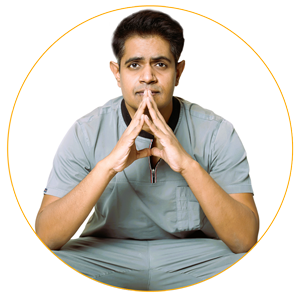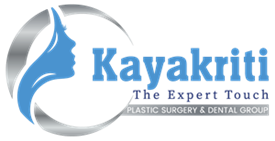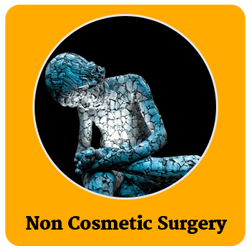Craniofacial Microsomia
In Craniofacial Microsomia, the development of the skull & face is primarily affected since birth and the affected part of the face is small when compared to the other side.

Best treatmet for Craniofacial Microsomia in India
What is Craniofacial Microsomia?
The word Mi crosomia means abnormally small structures of the body. In Craniofacial Microsomia, the development of the skull & face is primarily affected since birth and the affected part of the face is small when compared to the other side. There is marked facial asymmetry due to differences in size & shape of facial structures between the right & left sides of the facial structures.
It is the second most common birth defect affecting the face. It usually affects the ears & jaw, but can also affect the eyes, cheeks & bones of the neck. The affected structures appear smaller than normal.
This congenital abnormality is seen more in boys than girls. The condition is typically nonprogressive, meaning that the areas of the face that are affected at birth will typically remain similarly affected throughout growth and development, neither worsening nor getting better.
Craniofacial microsomia has many names, including
- Hemifacial microsomia
- Lateral facial dysplasia
Surgery can address many of these issues. It takes time and multiple procedures to maximize functioning and cosmetic results.
Craniofacial microsomia can affect
- Cheekbones.
- Eyes.
- Facial nerve
- Lower jaw.
- Muscles.
- Neck.
Rarely, Craniofacial microsomia involves other body systems, bones,s, and soft tissues, like the heart, kidneys, ribs, and spine.
Though this condition doesn't limit the life expectancy of a disease, it does hamper the quality of life of the patient. Such patients require strong family support & may at a later stage require a psychologist to cope with the psychological stresses.
What is the cause for Craniofacial Microsomia?
The reason for craniofacial microsomia is unknown. The malformation of this disease starts in the first trimester during pregnancy & may be caused by vascular problems leading to the poor blood supply to the face of the fetus.
The chance of inheriting this disease is very minimal. The risk of craniofacial microsomia can also be increased by environmental factors, such as certain drugs taken by the mother during pregnancy.
What are the Symptoms and parts affected by Craniofacial microsomia?
Usually, one side of the face is affected only and the other side is normal. Rarely, do u get the involvement of both sides of your face in craniofacial microsomia.
Ears
- Abnormal ear positioning and shape
- Microtia (small ear) or anotia (absent ear)
- Hearing loss.
- Missing ear canal.
- Skin tags in front of the ear
Eyes
- Inability to fully close one eye because of facial nerve palsy
- Missing or small one eye.
- Epibulbar dermoids (cystic swelling around the eyes)
- Vision problems.
Face
- Flattened forehead or cheek.
- Facial nerve palsy leads to paralysis of muscles on one side of the face.
- Small underdeveloped facial muscles.
Mouth
- Cleft lip or palate resulting in difficulty in speaking, swallowing, or eating.
- Narrow jaw.Smallmouth opening or tongue.
- Uneven smile due to paralysis of muscles on one side of the face
- Wide mouth if cleft of lip present on the angle of mouth.
Teeth
- Abnormally shaped or missing teeth.
- Delays in tooth development.
- Malocclusion.
How is the Diagnosis of Craniofacial Microsomia made?
The diagnosis of craniofacial microsomia is made based on the characteristic features of the face as described above. Few other supplementary investigations are done to rule out other conditions associated with it-
- MRI brain in selected patients.
- CT scan of the face is done for planning the bony reconstruction.
- Echocardiogram-to rule out any defect in the heart
- Renal ultrasound- to rule out any defect in the kidney
- Spine X-ray-to rule out any defects in the spine
Treatment of Craniofacial Microsomia
There is no medical treatment or medicine available to correct the condition of the deformity of the face. Deformity of the face can be corrected with surgery only. Usually, multiple stages of surgeries are required to correct the different deformities of the face which are done as the child grows.
Different Cases
- If the child has Cleft lip and palate repair- Surgery is done at 3 months to 1 year of age. Lip repair is when the child is a minimum of 3-5 months and palate repair is when the child is a minimum of 9 months old. If the child has Ear tags, they can be removed along with this surgery.
- As the child grows, the child will have dental problems. Tooth extraction and adjustments are done to relieve decay, overcrowding, and severe alignment issues.
- If the child has microtia (small undeveloped ears) or anotia (absent ear), it can be reconstructed at the age of 8 years with the help of rib cartilage to enhance the outer appearance of the malformed ear. A minimum of 3 stages would be required for complete ear reconstruction.
- Cochlear Implants are placed in the inner ear by an ENT specialist if hearing issues are present in the child.
- Dental implants are done by an experienced dental surgeon for missing or extracted teeth.
- Implantation of artificial eye and Enlargement of small eye socket if the eye is deformed.
- Jaw lengthening is required as one side of the lower jaw is underdeveloped and small in craniofacial microsomia. The majority of patients with severe mandibular hypoplasia are considered for osteotomy with Distraction Osteogenesis. In such cases, bone of the lower is cut but is not advanced. An internal or external distractor is fixed to both the segments to gradually bring the lower jaw (mandible) forwards daily after the surgery.
- Jaw Advancement Surgery- The upper & lower jaws of the face are moved forward or backward to improve the occlusal contact & help the patient improve his/her bite. This is done with the help of various Osteotomy Techniques and is usually done when the child has attained skeletal maturity at the age of 16 to 18 years.
- Soft tissue and bone reconstruction to restore facial symmetry. Reconstruction with the help of bone grafts & flaps is of prime importance.
- Facial reanimation surgery to improve facial symmetry and restore/optimize facial movement
Distraction can be of 2 types - Internal & External
- In case of internal distraction, the internal distraction systems are buried underneath the mucosa & are activated between 4 to 5 days after surgery (bone is advanced in the forward direction) & kept underneath for about 4 to 6 weeks after which the system is removed.
- In the case of an external fixator, the fixator device is secured to the cranium (head) during the activation period. A splint is attached to the mandible. The activation interval is the same as that of the internal fixator.
Non-surgical Treatment
- Preoperative or postoperative orthodontic treatment may be required for better results.
- In case of mild hearing defects, hearing aids may be required.
- To improve speech & swallowing defects, speech therapy treatment may be required which comprises of a few sessions at regular intervals.
Know your surgeon better

Best plastic surgeon, Dr. Amit Agarwal is an American Board Certified, extensively trained, and best Plastic & Aesthetic surgeon in Lucknow. He is the Chief Plastic Surgeon heading the Department of Plastic, Microvascular, and Craniofacial surgery at Vivekananda Polyclinic and Institute of Medical Sciences, Lucknow, U.P, India. He maintains a busy practice at Avadh and Nishat Hospital and his own center - Kayakriti Plastic Surgery & Dental Center. He was formerly a Consultant in the Department of Plastic Surgery and Burns at the prestigious SGPGI, Lucknow.
MS, DNB (General Surgery) MCh, DNB (Plastic Surgery),
MNAMS, FACS, FICS, FRCS (Edinburgh, UK)
His Credentials
Three pillars of kayakriti
Privacy
We believe your experience with us should be comfortable and hassle-free to make it one of your best lifetime experiences for yours. We, here at the clinic, take full precautions to maintain your privacy in any manner. We also provide a staff who will receive you from the gate and take you to the chamber directly if you demand.
Trust
Our Surgeon is highly qualified and internationally certified with a team of skilled staff to perform any surgical or non-surgical treatment on your body.
Safety
When you plan to undergo any surgery you should always keep in mind that it's your body and it's a surgery. We, here always keep your safety a priority and will never recommend you to undergo any such procedure which is not safe for you. We also provide you with a detailed description of the complications which may occur after the surgery during the consultation as it's a surgical procedure so there may be some complications depending on the way your body reacts.
Kayakriti in news



Frequently Asked Questions
If you have flat or small breast and you want to improve your breast and hip contour ratio then you are a good candidate for it. The answer will be best provided after the first consultation with Dr Amit Agarwal.
Acute pain will be there for almost a week which gradually reduces and there will be soreness and swelling which may take up to 3 weeks to subside.
You can join your work and daily routines after a week of the procedure and can start exercising after 3 weeks of it.
Yes, you have to wear it round the clock unless we suggest you to remove it.
This surgery does not affect the ducts or the areas of the breast involved in milk production. Thus, it does not affect the breast feeding.
This surgery does not affect the ducts or the areas of the breast involved in milk production. Thus, it does not affect the breast feeding.












Kayakriti Plastic Surgery & Dental Center
D-43, Near Punjab National Bank, Rajajipuram, Lucknow, Uttar Pradesh - 226017, India
Phone No. +919695940009, +919695940006
Map Location





























Social Media Presence